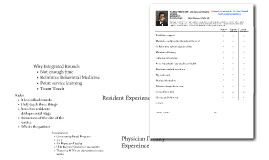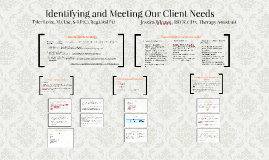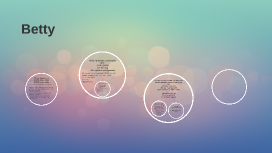Rounds Presentation
Transcript: Team - SLP, OT, TA 4-5 sessions/client Ax 2-3 Tx sessions with TA Follow up/Prescription Waitlist management 12 clients Phone History prior to Ax Plan: 3 Goals “The goal is to connect these children and youth to the services they need as early as possible and improve the service experience of families in three key areas: 1. Identifying kids earlier and getting them the right help sooner Trained providers ...will screen for potential risks to the child’s development as early as possible. 2. Coordinating service planning New service planning coordinators ... will connect families to the right services and supports. 3. Making supports and service delivery seamless Integrating the delivery of rehabilitation services...Services will be easier to access and seamless from birth through the school years.” (http://www.children.gov.on.ca/htdocs/English/topics/specialneeds/strategy/index.aspx) Barriers and Reflections Barriers Identifying and Meeting Our Client Needs 1. Increasing awareness amongst first responder community. 2. Offering resources and training , e.g., CDAC for frontline workers, and possibly sharing information via catchment agencies’ web sites. 3. Review role of signifier/arm band (with or without CAN symbol). The client and family may make use of aid (if their preference) in order to help first responder. 1. Kingston ACS Screening Clinic Screening Assessment Existing Screening Measures 2. Early AAC Intervention. Triaging select clients on waitlist. Prospective clients may not benefit from high tech intervention. Offered recommendations and treatment. Placement on wait list removed or adjusted accordingly. Minimizing/mitigating service gaps, i.e., more seamless service. 9 clients seen across 3 clinics: Language Express (PSL Smiths Falls); Pathways for Children & Youth (IBI); and Early Expressions (PSL Kingston) 5/9 referrals, i.e., 4 potentially inappropriate referrals not received. *Community providers rated quality of service and benefit of recommendations 5/5. Satisfaction and meeting clients' needs 4/5. Liked specific activity examples and strategies most. Results Preliminary Planning Stage Tyler Levee, M.Cl.Sc, S-LP (C), Reg.CASLPO Problem 6/12 clients seen Purpose and rationale Community partners promote use of high tech systems for face-to-face communication. Sometimes inappropriate suggestions for system and/or implementation made. Opportunity to offer recommendations, suggest system or resource. Occasionally inappropriate referrals received, e.g., a client has functional speech or he/she is preintentional or not a symbol user. Meeting needs across large catchment and narrows/shortens wait list. 3. Identification of Communication Needs to First Responders Jessica Whynot, RECE,CDA, Therapy Assistant Long waitlist Complex cases Not necessarily appropriate for high tech Proposed initiatives to meet these needs: Concerns, Barriers, and Benefits Clients not appropriate for high tech - sent with low tech goals to work on One-to-one Tx - clinic is consultative Integrated services with other teams (Special Needs Strategy) Composite checklist of essential AAC skills, e.g., intentional communication attempts, recognition and discrimination of symbols Obtain additional valuable information inc. ability to match item to category, access needs, etc. Serves as guideline Communication and Symbolic Behaviour Scales – Developmental Profile (CSBS-DP) Augmentative Communication Interaction Checklist (Church & Glennen, 1992) Meaningful Use of Speech Scale (MUSS) (Robbins & Osberger, 1992) Augmentative and Alternative Communication Information and Needs Assessment (Beukelman & Mirenda, 1992) Communication Matrix (Rowland, 2004) Interactive Checklist for Augmentative Communication (INCH) (Bolton & Dashiell, 1991) Greater sensitivity than specificity? I.e., based on items alone, it is not great at identifying those who meet criteria but would not be eligible for prescription (emerging speech, unintelligible speech, DAS). Poor reliability? Recognition and discrimination for novel symbols. Some clients were able to demonstrate skills only after multiple teaching trials. Others were able to demonstrate skills with own device, symbols. Inconsistent intake (coordinator vs. community ACS clinician) and misunderstanding amongst community providers. Resource intensive. Assessment Overview Special Needs Strategy Scheduling/time of the year Referral information was outdated SLP only available one day per week Avoid stigmatization. Are clients visibly labeled by wearing signal and/or arm band? Do specific goals outweigh this concern? Client needs may/may not be visible. Benefit for first responders to seek out system/device, seek contact information, ask family or guardians about need for system. Nil traction with regional EMS. A number of contacts made. Possible to collaborate at provincial level? Soliciting honest feedback re. the proposal, contacts and coordination process. Please see

















